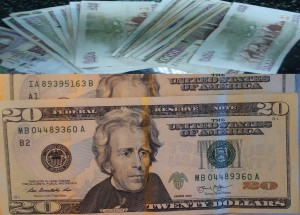 Demand and supply conditions determining prevalent exchange rates:
Demand and supply conditions determining prevalent exchange rates:
Export activities: Higher demand for locally produced goods and services in foreign markets means that foreign buyers are seeking more of the local currency (giving away their foreign currency) and this strengthens the local currency. Export commodities like horticulture, tea, coffee, beef, fish, cocoa, tourist packages, citizens working for foreign organisations within the country in question.
Import activities: Higher demand for foreign currency to use for imports of goods and services weakens the local currency. Paying for imported fertilizer, machines, equipment, foreign experts, imported clothes, paying for tuition and upkeep in foreign institutions of learning peak around some periods of the year.
A large diaspora community regularly sending foreign currency to their home country (i.e. raising demand for the domestic currency) serves to strengthen that local currency. International athletes or players bringing international currency home have a similar effect.
Increased value and/or volume of exports may also serve to strengthen the local currency ceteris paribus.
A huge import bill serves to weaken the local currency.
Whether a strong or weak currency is better for a country depends on the structure of its economy. When a currency is weak, foreign buyers peceive products from that country as being more affordable (they need to give fewer currency units from their home country in exchange for more units of the weaker currency of the country from which they are importing). This may serve to raise export volumes and contribute to growth (provided the increased sales volumes also translate to increased value growth).
Meanwhile, importers perceive foreign manufactured goods as being relatively expensive hence they may limit or postpone their import decisions. This may be good were it only to affect the importation of consumer but not investment goods. In such a case a weaker currency may benefit a country with significant export activities. Unfortunately, weak domestic currencies also hinder the importation of investment goods and this may curtail growth. A similar analysis may be done in a case where a country’s currency is strong (favours imports but partially hinders exports).
A country which manufactures its own investment goods, has adequate technology (skilled labour) within its borders and exports in large volumes may reap benefits from a weaker currency.